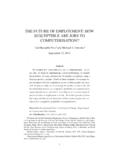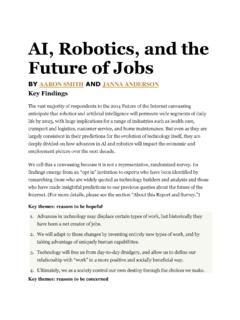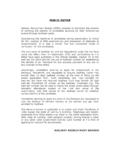Transcription of THE FUTURE OF EMPLOYMENT: HOW SUSCEPTIBLE …
1 THE FUTURE OF employment : HOWSUSCEPTIBLE ARE jobs TOCOMPUTERISATION? Carl Benedikt Frey and Michael A. Osborne September 17, examine how SUSCEPTIBLE jobs are to computerisation. To as-sess this, we begin by implementing a novel methodology to estimatethe probability of computerisation for 702 detailed occupations, using aGaussian process classifier. Based on these estimates, we examine ex-pected impacts of FUTURE computerisation onUSlabour market outcomes,with the primary objective of analysing the number of jobs atrisk andthe relationship between an occupation s probability of computerisation,wages and educational attainment.
2 According to our estimates, about 47percent of totalUSemployment is at risk. We further provide evidencethat wages and educational attainment exhibit a strong negative relation-ship with an occupation s probability of :Occupational Choice, Technological Change, Wage Inequal-ity, employment , Skill DemandJELC lassification:E24, J24, J31, J62, O33. We thank the Oxford University Engineering Sciences Department and the Oxford Mar-tin Programme on the Impacts of FUTURE Technology for hosting the Machines and Employ-ment Workshop. We are indebted to Stuart Armstrong, Nick Bostrom, Eris Chinellato, MarkCummins, Daniel Dewey, David Dorn, Alex Flint, Claudia Goldin, John Muellbauer, VincentMueller, Paul Newman, Se n h igeartaigh, Anders Sandberg, Murray Shanahan, and KeithWoolcock for their excellent suggestions.
3 Oxford Martin School, University of Oxford, Oxford, OX1 1PT, United Department of Engineering Science, University of Oxford, Oxford, OX1 3PJ, United King-dom, INTRODUCTIONIn this paper, we address the question: how SUSCEPTIBLE are jobs to computerisa-tion? Doing so, we build on the existing literature in two ways. First, drawingupon recent advances in Machine Learning (ML) and Mobile Robotics (MR),we develop a novel methodology to categorise occupations according to theirsusceptibility to , we implement this methodology toestimate the probability of computerisation for 702 detailed occupations, andexamine expected impacts of FUTURE computerisation onUSlabour market paper is motivated by John Maynard Keynes s frequently cited pre-diction of widespread technological unemployment due to our discovery ofmeans of economising the use of labour outrunning the pace atwhich wecan find new uses for labour (Keynes, 1933, p.)
4 3). Indeed, over the pastdecades, computers have substituted for a number of jobs , including the func-tions of bookkeepers, cashiers and telephone operators (Bresnahan, 1999; MGI,2013). More recently, the poor performance of labour markets across advancedeconomies has intensified the debate about technological unemployment amongeconomists. While there is ongoing disagreement about the driving forcesbehind the persistently high unemployment rates, a number of scholars havepointed at computer-controlled equipment as a possible explanation for recentjobless growth (see, for example, Brynjolfsson and McAfee,2011).
5 2 The impact of computerisation on labour market outcomes is well-establishedin the literature, documenting the decline of employment inroutine intensiveoccupations mainly consisting of tasks following well-definedprocedures that can easily be performed by sophisticated algorithms. For exam-ple, studies by Charles,et al.(2013) and Jaimovich and Siu (2012) emphasisethat the ongoing decline in manufacturing employment and the disappearanceof other routine jobs is causing the current low rates of ad-1We refer to computerisation as job automation by means of computer-controlled view finds support in a recent survey by the McKinsey Global Institute (MGI), showingthat 44 percent of firms which reduced their headcount since the financial crisis of 2008 haddone so by means of automation (MGI, 2011).
6 3 Because the core job tasks of manufacturing occupations follow well-defined repetitiveprocedures, they can easily be codified in computer softwareand thus performed by computers(Acemoglu and Autor, 2011).2dition to the computerisation of routine manufacturing tasks, Autor and Dorn(2013) document a structural shift in the labour market, with workers reallo-cating their labour supply from middle-income manufacturing to low-incomeservice occupations. Arguably, this is because the manual tasks of service occu-pations are less SUSCEPTIBLE to computerisation, as they require a higher degreeof flexibility and physical adaptability (Autor,et al.)
7 , 2003; Goos and Manning,2007; Autor and Dorn, 2013).At the same time, with falling prices of computing, problem-solving skillsare becoming relatively productive, explaining the substantial employment growthin occupations involving cognitive tasks where skilled labour has a comparativeadvantage, as well as the persistent increase in returns to education (Katz andMurphy, 1992; Acemoglu, 2002; Autor and Dorn, 2013). The title Lousy andLovely jobs , of recent work by Goos and Manning (2007), thuscaptures theessence of the current trend towards labour market polarization, with growingemployment in high-income cognitive jobs and low-income manual occupa-tions, accompanied by a hollowing-out of middle-income routine to Brynjolfsson and McAfee (2011), the pace of technologi-cal innovation is still increasing, with more sophisticated software technolo-gies disrupting labour markets by making workers redundant.
8 What is strikingabout the examples in their book is that computerisation is no longer confinedto routine manufacturing tasks. The autonomous driverlesscars, developed byGoogle, provide one example of how manual tasks in transportand logisticsmay soon be automated. In the section In Domain After Domain, Comput-ers Race Ahead , they emphasise how fast moving these developments havebeen. Less than ten years ago, in the chapter Why People Still Matter , Levyand Murnane (2004) pointed at the difficulties of replicating human perception,asserting that driving in traffic is insusceptible to automation: But execut-ing a left turn against oncoming traffic involves so many factors that it is hardto imagine discovering the set of rules that can replicate a driver s behaviour[.]
9 ] . Six years later, in October 2010, Google announced that it had modi-fied several Toyota Priuses to be fully autonomous (Brynjolfsson and McAfee,2011).To our knowledge, no study has yet quantified what recent technologicalprogress is likely to mean for the FUTURE of employment . The present studyintends to bridge this gap in the literature. Although thereare indeed existing3useful frameworks for examining the impact of computers on the occupationalemployment composition, they seem inadequate in explaining the impact oftechnological trends going beyond the computerisation of routine tasks.
10 Semi-nal work by Autor,et al.(2003), for example, distinguishes between cognitiveand manual tasks on the one hand, and routine and non-routinetasks on theother. While the computer substitution for both cognitive and manual routinetasks is evident, non-routine tasks involve everything from legal writing, truckdriving and medical diagnoses, to persuading and selling. In the present study,we will argue that legal writing and truck driving will soon be automated, whilepersuading, for instance, will not. Drawing upon recent developments in En-gineering Sciences, and in particular advances in the fieldsofML, includingData Mining, Machine Vision, Computational Statistics andother sub-fields ofArtificial Intelligence, as well asMR, we derive additional dimensions requiredto understand the susceptibility of jobs to computerisation.







